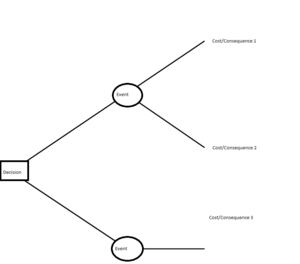Decision Tree: Risk & Opportunities
(→Method Description) |
(→Method Description) |
||
| Line 9: | Line 9: | ||
[[File:Decision1.PNG|300px|right|thumb|Decision tree of the production factory's water problem.<ref name="Probability" />]] | [[File:Decision1.PNG|300px|right|thumb|Decision tree of the production factory's water problem.<ref name="Probability" />]] | ||
| − | The decision tree is used to evaluate the risk and cost within a project. It can be used for feasibility studies, reassessment of existing structures or shutdown of old structures. An example to use this is: a production factory is being build but would need a source of water which could provide 100 units of water per day. They have two options to comply the requirements. One is establishing a local well which cost 10 monetary units. The well have one problem it only has 40% chance that it would be able to provide the 100 units of water each day. The other option is til establish a pipeline with 100% chance of delivering the amount of water needed but a cost of 100 monetary units. The decision tree is then set up to evaluate the cost/consequences depending on the which option taken. <Br> | + | The decision tree is used to evaluate the risk and cost within a project. It can be used for feasibility studies, reassessment of existing structures or shutdown of old structures. An example to use this is: a production factory is being build but would need a source of water which could provide 100 units of water per day. They have two options to comply the requirements. One is establishing a local well which cost 10 monetary units. The well have one problem it only has 40% chance that it would be able to provide the 100 units of water each day. The other option is til establish a pipeline with 100% chance of delivering the amount of water needed but a cost of 100 monetary units. The decision tree is then set up to evaluate the cost/consequences depending on the which option taken seen on the figure to the right. <Br> |
There are three stages in the decision tree: <Br> | There are three stages in the decision tree: <Br> | ||
● A decision node (square) <Br> | ● A decision node (square) <Br> | ||
● A chance node (circle) <Br> | ● A chance node (circle) <Br> | ||
● A cost/consequence node <Br> | ● A cost/consequence node <Br> | ||
| + | For the production factory first the decision between a well or a pipeline leads to two paths. Establishing the pipeline lead to the expensive option with no chance of failure. By however by establishing the well leads to a chance node with 40% success rate and 60% failure. If the well is a success the lowest cost is obtained with only the use of 10 monetary units. However if the well is a failure they would have to also build the pipeline and the total cost would be 110 monetary units. | ||
== Application == | == Application == | ||
Revision as of 08:45, 21 September 2017
Contents |
Abstract
Uncertainty is a massive issue in project management and can lead to high cost and disadvantages if not handled correctly. The project manager must therefore be able to make the best decisions based on the information available.
The decision tree is a tool that can aid the project manager to ensure the best outcome of a problem.
It is based on a tree-like model where each branch is a path of decisions and possible events. Each step include the cost and possibility of that event to occur.
By identifying all the possible events and their chance to occur it gives the project manager the ability to calculate the highest probability for each path.
When combining this with the cost of each event the project manager is able to estimate the cost/benefits for each decision.
Method Description

The decision tree is used to evaluate the risk and cost within a project. It can be used for feasibility studies, reassessment of existing structures or shutdown of old structures. An example to use this is: a production factory is being build but would need a source of water which could provide 100 units of water per day. They have two options to comply the requirements. One is establishing a local well which cost 10 monetary units. The well have one problem it only has 40% chance that it would be able to provide the 100 units of water each day. The other option is til establish a pipeline with 100% chance of delivering the amount of water needed but a cost of 100 monetary units. The decision tree is then set up to evaluate the cost/consequences depending on the which option taken seen on the figure to the right.
There are three stages in the decision tree:
● A decision node (square)
● A chance node (circle)
● A cost/consequence node
For the production factory first the decision between a well or a pipeline leads to two paths. Establishing the pipeline lead to the expensive option with no chance of failure. By however by establishing the well leads to a chance node with 40% success rate and 60% failure. If the well is a success the lowest cost is obtained with only the use of 10 monetary units. However if the well is a failure they would have to also build the pipeline and the total cost would be 110 monetary units.
Application
Limitations
Alternatives
Annotated Bibliography
References
- ↑ Michael Havbro (2010) Statistics and Probability Theory - In Pursuit of Engineering Decision Support, Publisher : Springer International Publishing.